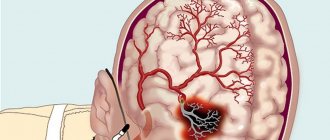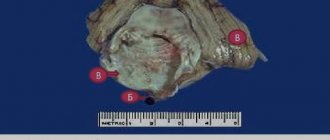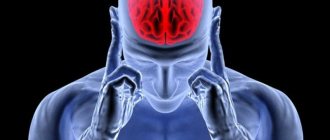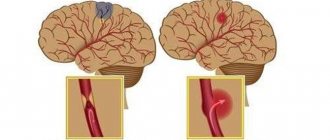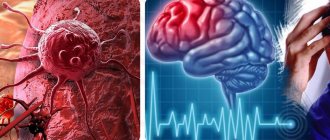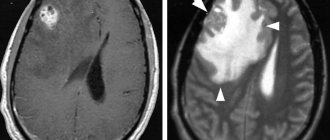Learn more about diseases starting with the letter “L”: Lacunar cerebral infarction, Mild cognitive impairment, Leukodystrophy, Schilder’s leukoencephalitis, Drug-induced parkinsonism, Lethargic encephalitis, Frontal syndrome, Lumbago, Lumboischialgia.
What is lacunar cerebral infarction?
Lacunar cerebral infarction is, in other words, a stroke of an ischemic nature that affects a small area of cerebral tissue, where a lacuna subsequently forms. The presented pathology can manifest itself as a result of many external and internal factors. When affected by such a disease, the patient is diagnosed with a variety of symptoms that are unable to reach serious manifestations. With further development, the patient begins to develop cognitive impairment. Doctors perform clinical procedures and instrumental testing as diagnostic procedures.
However, it is worth understanding that such anomalies cannot be detected using neuromodeling methods. Treatment is carried out in a complex, which includes etiopathogenetic, vascular, neuroprotective therapy, as well as relief from inherent symptoms.
Symptoms of cerebral infarction
Symptoms of a cerebral infarction depend on where the lesion is located.
However, general symptoms of this pathological process can be identified, including:
- Headache;
- Loss of consciousness, sometimes coma may develop;
- Dizziness;
- Disturbances in the functioning of the pelvic organs;
- Pain in the eyeballs;
- Feeling hot;
- Dry mouth;
- Nausea and vomiting accompanied by severe headache;
- Convulsions (not always present).
If the focus of a cerebral infarction is localized in the right hemisphere, then the following clinical picture is characteristic:
- Complete immobility (hemiparesis) or significant decrease in strength (hemiplegia) of the left limbs;
- Sensitivity in the left half of the body and face disappears or sharply decreases;
- Speech impairment will be observed in left-handed people. In right-handed people, speech disorders develop exclusively when the left hemisphere is damaged. The patient cannot reproduce words, but conscious gestures and facial expressions are preserved;
- The face becomes asymmetrical: the left corner of the mouth goes down, the nasolabial fold is smoothed out.
Depending on which half of the brain is damaged, symptoms of a cerebral infarction will be observed on the opposite side. That is, if the lesion is located in the left hemisphere, then the right half of the body will suffer.
If a cerebral infarction develops in the vertebrobasilar vascular system, then the patient’s symptoms are as follows:
- Dizziness that increases when you tilt your head back;
- Coordination suffers, static disorders are observed;
- There are disturbances in the movement of the eyeballs, vision deteriorates;
- A person pronounces individual letters with difficulty;
- Problems with swallowing food appear;
- Speech becomes quiet, hoarseness appears in the voice;
- Paralysis, paresis, and loss of sensation in the limbs will be observed on the side opposite to the lesion.
It is worth considering separately the symptoms of cerebral infarction depending on which cerebral artery is damaged:
- Anterior cerebral artery – incomplete paralysis of the legs, the occurrence of grasping reflexes, impaired eye movements, motor aphasia;
- Middle cerebral artery – incomplete paralysis and sensitivity disorder of the hands, as well as the lower half of the face, sensory and motor aphasia, laterofixation of the head;
- Posterior cerebral artery – visual disturbances, the patient understands the speech of another person, can speak himself, but he forgets most words.
In severe cases, consciousness is depressed and the person falls into a coma, which can occur when any part of the brain is damaged.
Brief information
Lacunar infarction is a type of serious malfunction in the functioning of the circulatory system of the brain, as a result of which small cavities begin to form in the human body in places where atrophied cerebral tissue is localized after suffering ischemia. The designations for such depressions were invented back in the 19th century, thanks to the medical scientist Fendal. It was he who was the first to name the identified pathological processes in patients suffering from arterial hypertension.
A detailed description of the presented disease was given later in the mid-60s of the last century. Professor Fisher revealed its direct dependence on encephalopathy of hypertensive nature. According to average statistics, a similar disease is diagnosed in approximately a third of patients diagnosed with stroke. Due to the small volume of lesions and minimal consequences, lacunar abnormalities have long been considered benign. But after carrying out certain studies in the field of neurology in a clinical setting, it became clear that such a disorder causes the development of cognitive deficits, the secondary stage of Parkinson's disease and some mental instability.
Consequences of cerebral infarction
The consequences of a cerebral infarction can be very serious and often pose a direct threat to human life, among them are:
- Brain swelling. It is this complication that develops more often than others and is the most common cause of death of a patient in the first week after an ischemic stroke;
- Congestive pneumonia is the result of the patient being in a horizontal position for a long time. It most often develops 3-4 weeks after a cerebral infarction;
- Pulmonary embolism;
- Acute heart failure;
- Bedsores due to the patient lying motionless in bed for a long time.
In addition to the listed consequences of cerebral infarction, which develop in the early stages, long-term complications can also be identified, including:
- Impaired motor function of the limbs;
- Decreased sensation in the arms, legs and face;
- Speech problems;
- Deterioration of mental abilities;
- Mental disorders;
- Difficulty swallowing food;
- Coordination problems when walking and turning;
- Epileptic seizures (up to 10% of people who have had a cerebral infarction are susceptible to them);
- Malfunctions of the pelvic organs (bladder, kidneys, intestines, reproductive organs suffer).
Pathogens
The described disease can manifest itself as a result of a failure in the blood supply in one of the perforating vessels of the arteries. In almost 80% of lesions, the area of change is the white matter of the cerebral region, located in the subcortical zone and the inner shell, in the remaining 20% - in the base and bridge. Typically, the main cause of progression of deformities is chronic arterial hypertension. Due to this, anomalies begin to appear in the walls of the vascular canals. In the case of such a process, the patient experiences a decrease in the lumen of the artery, which entails problems in the circulatory system, which supplies a certain area of cerebrotissue. After this, signs of ischemia and death appear in the affected lobe; subsequently, a hole is formed in place of the removed cells.
The main etiological sources of the disease are:
- Chronic disease of the arteries of the elastic and muscular-elastic type, renal failure with an increased number of creatinine in the blood cells.
- Diabetes.
- Alcohol abuse.
- The chronic stage of obstructive disorders occurring in the pulmonary apparatus.
- Infectious agents that have entered the body.
- Autoimmune diseases, etc.
What is the difference between a cerebral infarction and a stroke?
When a cerebral infarction occurs, the blood supply to the brain is disrupted, as a result of which the tissues of the affected area begin to die. Insufficient blood flow to the brain occurs due to atherosclerotic plaques that prevent its normal flow, due to heart rhythm disturbances, or due to problems with the blood coagulation system.
With a hemorrhagic stroke of the brain, on the contrary, the blood flow to it increases, which causes an artery rupture. The cause is vascular pathologies or hypertensive crisis.
There are differences in the course of the disease. Thus, cerebral infarction develops gradually, over several hours or even days, and hemorrhagic stroke occurs almost instantly.
Manifestations
Typically, the pathology manifests itself with a rapid onset of focal manifestations within a couple of hours. But there are cases when the violation occurs in stages with a gradual increase in the number of problems (this period can last from 72 hours to 6 days). At certain moments, transistor attacks of an ischemic nature are distinguished. In addition, with a lacunar infarction, cerebral symptoms, disturbances in the cortical regions and meningeal phenomena are not noticed. Consciousness remains clear and distinct. Also, the patient has the following symptoms:
- Hemiparesis.
- Sensory problems.
- Loss of the ability to independently perform physical activity.
- Problems with the speech apparatus.
- Pelvic dysfunction.
- Pseudobulbar anomaly.
- Neurological abnormalities.
- Depressive state.
- Difficulty concentrating and remembering received information.
- Decreased level of intellectual abilities.
- Slow thinking.
If such phenomena are neglected, a person begins a rapid progression of the disease, as a result of which the degree of cognitive imbalance begins to increase. The patient ceases to perceive any information, and there is a loss of motor reflexes.
Causes of cerebral infarction
The following causes of cerebral infarction are distinguished:
- Atherosclerosis. It develops in men earlier than in women, since at a young age female blood vessels are protected from atherosclerotic lesions by sex hormones. The coronary arteries are the first to be affected, then the carotid ones, and subsequently the cerebral blood supply system;
- Hypertension. Mild hypertension (pressure up to 150/100 mm Hg), which is the most dangerous, enhances atherosclerosis and disrupts the adaptive reactions of the arteries;
- Heart diseases. Thus, people who have had a myocardial infarction have a high risk of developing a cerebral infarction. In 8% of patients after myocardial infarction, ischemic stroke will develop within the first month, and in 25% of patients - within six months. Coronary heart disease and heart failure are also dangerous;
- High blood viscosity;
- Atrial fibrillation. They cause blood clots to form in the left atrial appendage, which are subsequently transported to the brain;
- Disorders of the endocrine system, primarily diabetes mellitus;
- Vascular diseases (pathologies of their development, Takayasu's disease, anemia, leukemia, malignant tumors).
In addition, do not forget about risk factors that increase the likelihood of a cerebral infarction, including:
- Age (every ten years of life increases the risk of developing cerebral infarction by 5-8 times);
- Hereditary predisposition;
- Physical inactivity;
- Excess weight;
- Smoking (if this bad habit is supplemented by taking oral contraceptives, then smoking becomes a leading risk factor for the development of cerebral infarction);
- Alcohol abuse;
- Acute stress or prolonged psycho-emotional stress.
Methods for diagnosing lacunar cerebral infarction
To establish a correct conclusion, a specialist in the field of neurology must take into account the presence in the readings of hypertensive diseases, severe arrhythmia, diabetes mellitus, transient ischemic attacks, the nuances of the clinical manifestations of the disease, the results of instrumental examinations, etc. The most popular procedures designed to search for such deformities include:
- Ophthalmoscopic testing.
- MRI scan or computed tomography.
- USGD analysis.
Treatment Options
The main goal of ridding patients of the disease is to stabilize and maintain normal blood pressure levels, as well as prevent the formation of cardioembolism and conduct and changes in lipid metabolism. In some situations, regular appointments with a cardiologist are prescribed to monitor the correctness of therapy. It is he who prescribes additional antihypertensive measures and the use of antithrombotic drugs. To correct lipid metabolism, doctors prescribe statins. Also, therapeutic treatment is carried out using neurotropic components. Positive effects were noticed by experts after performing special exercises aimed at developing attentiveness, improving memory and level of thinking. If the patient suffers from depression, mild antidepressants are prescribed.
Further prognosis for lacunar cerebral infarction
Experts report relatively favorable recovery results. With timely medical care and specific intensive therapy, the patient experiences a complete regression of neurological impairment. But there is a 30% chance of dementia, vascular problems and mental disorders. The risk increases significantly if the described anomaly recurs with a frequency of more than 12%. The experiments conducted indicate a third of survivors, most of whom were diagnosed with a resumption of symptoms.
Symptoms of ischemic stroke
Almost never a cerebral infarction is asymptomatic. You may have already come across actively distributed reminders on the timely recognition of a stroke: after all, it is very important to call an ambulance and provide medical assistance to the patient as early as possible - the earlier assistance is provided, the less brain damage.
The main symptoms of ischemic stroke are:
- dizziness,
- loss of orientation in space,
- vomit,
- convulsions,
- impaired coordination, speech, vision, writing, reading, swallowing,
- inability to move individual limbs and/or perform simple manipulations such as raising two arms at the same time, brushing teeth, or turning pages of a book.
The symptoms are extremely varied. They depend primarily on which particular part of the brain was deprived of blood supply - then exactly the function for which this part is responsible will be disrupted.
At the same time, all the symptoms do not appear; you may notice one or more - and this is a good reason to immediately call an ambulance.

